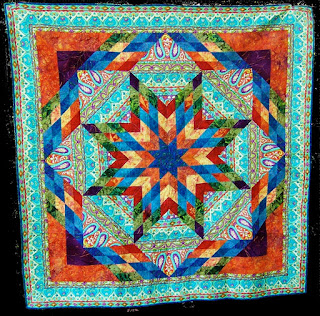Once again I considered adding appliqué in the corners but that would call for another medium blue and there's none in the stash. Plus, SIL would probably like feathers. Markings will show up easily on the white but so will mistakes.
 |
| Blue Lone Star quilt top 3 |
This traditional design runs in my family. My parents had a large version on their bed made by my grandmother. It was already a generation old when they got it and finally disintegrated when my kids were young. By using all our quilts daily, my mother sparked my lifelong interest in quilting. {Now I know who to blame.} So much better than storing it in a cupboard and never learning to appreciate handmade items.
In the late 80s, Catherine Anthony offered her final eight-week Master Quiltmaking class which I was clever enough to join. She and her daughter, Libby Lehman, wrote a set of books detailing six-inch blocks. Of course, I purchased the oversized books {but later passed them on during a move. It's hard to transport big paperbacks.} Catherine was a treasure-house of details about math calculations and precision sewing. Towards the end, we covered Lone Stars and I made a pillow which is long lost. No photos either but that traditional design was my first Lone Star.
In 2006 I took a class with Jan Krentz and made my second Lone Star for a friend. Her book Lone Star Quilts and Beyond is still available. It was in my library until recently.
The cotton sateen border print had been in my stash for a while. Most was used making a dust ruffle and trimming the curtains but it was so lovely I couldn't discard any.
 |
| Lone Star quilt 2 |
Here's a detail. Choosing fabrics was pretty easy - just match or tone with the border. Most are batiks or tone-on-tone prints. As you can tell, I don't worry about mixing different types of fabric.
 |
| Detail of Lone Star quilt 2 |
The border print reminds me of happy times creating our first home. Very fond memories.
Enjoy the day, Ann
Enjoy the day, Ann